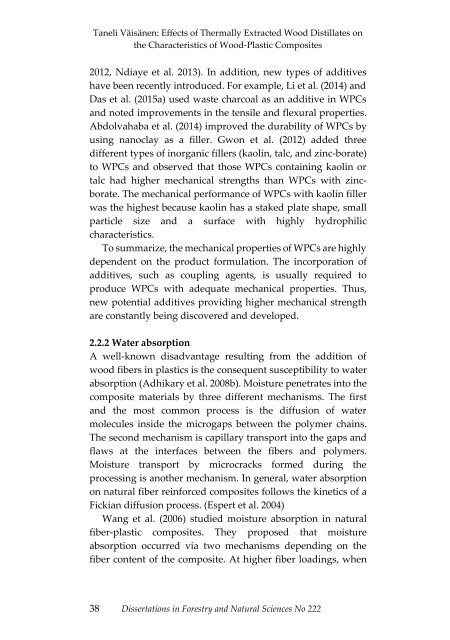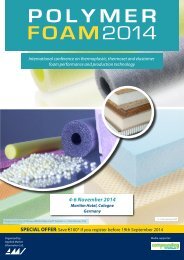Dissertations in Forestry and Natural Sciences
24lYKFN
24lYKFN
Create successful ePaper yourself
Turn your PDF publications into a flip-book with our unique Google optimized e-Paper software.
Taneli Väisänen: Effects of Thermally Extracted Wood Distillates on<br />
the Characteristics of Wood-Plastic Composites<br />
2012, Ndiaye et al. 2013). In addition, new types of additives<br />
have been recently <strong>in</strong>troduced. For example, Li et al. (2014) <strong>and</strong><br />
Das et al. (2015a) used waste charcoal as an additive <strong>in</strong> WPCs<br />
<strong>and</strong> noted improvements <strong>in</strong> the tensile <strong>and</strong> flexural properties.<br />
Abdolvahaba et al. (2014) improved the durability of WPCs by<br />
us<strong>in</strong>g nanoclay as a filler. Gwon et al. (2012) added three<br />
different types of <strong>in</strong>organic fillers (kaol<strong>in</strong>, talc, <strong>and</strong> z<strong>in</strong>c-borate)<br />
to WPCs <strong>and</strong> observed that those WPCs conta<strong>in</strong><strong>in</strong>g kaol<strong>in</strong> or<br />
talc had higher mechanical strengths than WPCs with z<strong>in</strong>cborate.<br />
The mechanical performance of WPCs with kaol<strong>in</strong> filler<br />
was the highest because kaol<strong>in</strong> has a staked plate shape, small<br />
particle size <strong>and</strong> a surface with highly hydrophilic<br />
characteristics.<br />
To summarize, the mechanical properties of WPCs are highly<br />
dependent on the product formulation. The <strong>in</strong>corporation of<br />
additives, such as coupl<strong>in</strong>g agents, is usually required to<br />
produce WPCs with adequate mechanical properties. Thus,<br />
new potential additives provid<strong>in</strong>g higher mechanical strength<br />
are constantly be<strong>in</strong>g discovered <strong>and</strong> developed.<br />
2.2.2 Water absorption<br />
A well-known disadvantage result<strong>in</strong>g from the addition of<br />
wood fibers <strong>in</strong> plastics is the consequent susceptibility to water<br />
absorption (Adhikary et al. 2008b). Moisture penetrates <strong>in</strong>to the<br />
composite materials by three different mechanisms. The first<br />
<strong>and</strong> the most common process is the diffusion of water<br />
molecules <strong>in</strong>side the microgaps between the polymer cha<strong>in</strong>s.<br />
The second mechanism is capillary transport <strong>in</strong>to the gaps <strong>and</strong><br />
flaws at the <strong>in</strong>terfaces between the fibers <strong>and</strong> polymers.<br />
Moisture transport by microcracks formed dur<strong>in</strong>g the<br />
process<strong>in</strong>g is another mechanism. In general, water absorption<br />
on natural fiber re<strong>in</strong>forced composites follows the k<strong>in</strong>etics of a<br />
Fickian diffusion process. (Espert et al. 2004)<br />
Wang et al. (2006) studied moisture absorption <strong>in</strong> natural<br />
fiber-plastic composites. They proposed that moisture<br />
absorption occurred via two mechanisms depend<strong>in</strong>g on the<br />
fiber content of the composite. At higher fiber load<strong>in</strong>gs, when<br />
38 <strong>Dissertations</strong> <strong>in</strong> <strong>Forestry</strong> <strong>and</strong> <strong>Natural</strong> <strong>Sciences</strong> No 222



